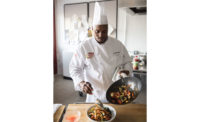Q&A with Stephen Hodge, Senior Executive Chef, ConAgra Foods
A senior executive chef’s perspective on spice trends

Stephen Hodge, CEC , Senior Executive Chef, ConAgra Foods

Latin Shrimp Cocktail with Rosarita Fire-Roasted Tomato Salsa


Prepared Foods talks spice flavor and formulation trends with Stephen Hodge, a senior executive chef with ConAgra Foods, Omaha, Neb.
Prepared Foods: What were 2015’s biggest spice trends?
Chef Stephen: Korean cuisine continues to gain more attention from consumers. This is evident by the rise of Korean markets, restaurants and shops in major metropolitan areas such as Midtown Manhattan in New York City. As people have experienced Kimchi, and ingredients such as Gochujang; their craving has increased for the depth of flavor that fermentation brings to food.
Korean cuisine is known for the many side dishes served during a meal and anticipation builds for what the next flavor experience will be in the next dish served. In turn, you see a domestic growth of chefs and mixologists pickling and fermenting fruits, vegetables and proteins to create ingredients for their signature dishes and drinks.
PF: How are spice trends evolving?
Chef Stephen: As the demand for less sugar, sodium and fat in food seem to be the norm for food products, so is the demand for authentic flavors and spices to create authentic dishes. Cuisine-forward spice blends are a way to deliver the flavor characteristics of a cuisine. When combined with flavor enhancing cooking techniques—such as grilling or roasting—we can achieve great flavor.
A Moroccan Spiced Chicken is a great example of delivering a dish with traditional spices consisting of cumin, garlic, cinnamon, cayenne, paprika and turmeric. These spices aren’t usually associated with any particular cuisine on their own—but combine them together—and now they become a recognizable spice-blend linked to North African cuisine.
PF: What’s a new spice you’re using more often? Why?
Chef Stephen: I grew about a dozen fennel plants last year in my garden. The fennel bulbs never seemed to get as big as the ones I’m used to seeing in the grocery stores, so I let them continue to grow and eventually they starting flowering. Eventually, I had an overabundant supply of fennel pollen from the yellow flowers, this was my new favorite spice. The pollen tastes like a sweeter fennel but with a hundred-fold intensity. I have included it in homemade sausages, salumi and meat rubs as well as a finishing spice for lentil soup and vinaigrettes; this has become my new favorite spice with my supply well hidden in the pantry.
PF: What have you learned about collaborating with food scientists and operations to capture the right finished spice notes in a product?
Chef Stephen: As a chef, we constantly strive to never miss opportunities to capture flavor. Those opportunities can come in the form of a cooking technique, such as sautéing the foundational ingredients for a sauce and using the right time and temperature to maximize those flavors. It’s also a process of knowing when to add seasonings and spices—whether it’s at the beginning of the process to harmonize the ingredients, or at the end to highlight a certain front note.
In a Jerk sauce, we may adjust the blending of ingredients to keep the habanero pepper at just the right level to create a slight back note of heat after we’ve enjoyed all of the other great ingredients first.
Originally appeared in the May, 2016 issue of Prepared Foods as FIRST PERSON.
Looking for a reprint of this article?
From high-res PDFs to custom plaques, order your copy today!







